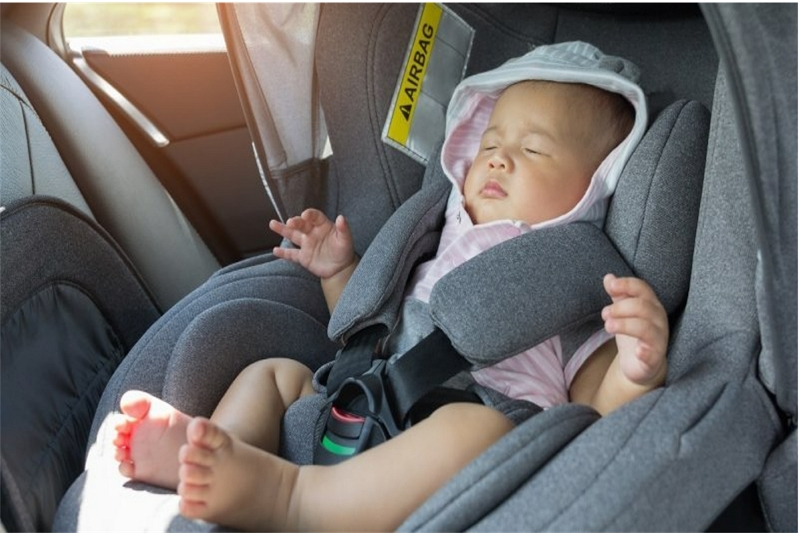You might be wondering how to install baby car seat rear facing. It is actually quite easy. Check out this blog post for how-to instructions and tips on how to make sure your child is safe while driving.

How Do You Install Baby Car Seat Rear Facing
When it comes to installing your baby car seat rear-facing, there are a few simple steps that will help you out.
First of all, the first thing you need is a place for installation on top of your headrests and an open belt path (an area through which the safety belts run), as well as a proper recline angle: 45 degrees or less. There should be no buckles pressing into your child’s legs when they occupy their infant car seat forward-facing.
If this happens with any regularity, consider switching from an outdated bucket-style design to one with a more modern harness system built in – such as those found in good convertible models like Graco Highback Turbo Booster seats.
In addition, avoid using a three-point harness with a booster – two separate components – as they’re not very safe.
Where Should Rear Facing Car Seats Be Placed?
Children should ride facing the rear of the vehicle until they are at least two years old or reach the highest weight limit allowed by their car seat’s manufacturer.
This is because children under age two who sit in forward-facing child restraints (car seats) face a higher risk of injury than those riding rear-facing.
How Do You Secure A Rear-Facing Car Seat?
The first step to securing your rear-facing car seat is reading the instruction manual. If you are unsure of how to install it or use certain features, contact the manufacturer before putting the child in the vehicle.
The next thing that parents should do is ensure that they can properly fit their baby into a rear-facing car seat. A five-point harness offers safety and security for children who need this type of restraint system up until they reach 40 lbs (18 kg).
You must purchase an appropriate model which makes sure there isn’t too much room between them and the product itself; otherwise, they could be ejected from it during a crash.
Parents also need to make sure their infant’s head doesn’t slump forward when sleeping because this puts strain on their necks. If the baby’s head is still too large for it, then they should use a convertible car seat in order to accommodate them better until they are ready for an adult belt system.
How Long Should A Baby Be In A Rear Facing Car Seat?
Children grow and change so quickly that you will probably need to switch your child’s car seat before they reach their first birthday.
However, this does not mean that rear-facing seats are no longer safe at one year of age. Rather it is an indication that the convertible or all-in-one style of car seat has outgrown its usefulness for your growing baby.
The most important consideration when deciding on how long to use a rear-facing car seat is safety. Convertible styles allow you more time because they can be used as both front-facing seats (for older infants) and backseat positions (infants).
All in Ones offer similar flexibility but lack head support until attached with the included infant insert which works well up through 20 pounds.
Should A Car Seat Go Behind The Driver Or Passenger?
It’s best to put a car seat behind the driver, especially if you are using an infant-only seat.
If your child is riding in their car seat and they can’t see out of it, then you want them to be able to easily turn around and look at you while talking or comforting them during an emergency stop.
This will also keep them from kicking the back of your passenger’s chair.
Can I Put A Rear-Facing Baby Seat In Front Of Car?
If possible try not to put them behind an airbag or in any other place where they could get hurt if there is an accident.
The best location for rear-facing infant seats is either directly behind someone who will drive (if that’s practical) or on the right side close against the backseat door (passenger).
On long trips check them regularly- especially younger babies because they tend to fall asleep more when placed higher up like this which might decrease circulation leading to breathing problems.
Do You Need To Turn Airbag Off For Forward Facing Car Seat?
No, you do not need to turn the airbag off for a forward-facing car seat. In a crash the child in a properly installed and used rear-facing car seat would come into contact with the back of the front passenger’s or driver’s seat before there was any risk from an inflating airbag.
Airbags are designed to inflate toward occupants only when it is necessary to cushion impacts at speeds where people can be badly hurt without them – typically above about 18 mph (30 km/h).
Since they know how fast cars go when they deploy, most modern systems will cut off power if anything blocks their sensing element while a vehicle is going slower than that threshold speed.
